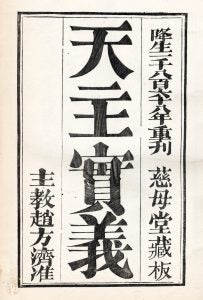Continuing our exploration of Matteo Ricci’s works in Chinese at Woodstock Theological Library (WTL), we feature here an image of the title page from an 1868 edition of his work entitled Tian zhu shi yi = 天主實義 , translated as The True Meaning of the Lord of Heaven.
 This book was his most famous and also most controversial because of its perceived anti-Buddhist sentiment. Ricci began work on this in 1595 and it was finally complete and printed in 1603. The book’s genre is that of the dialogue between a scholar of the West and a Chinese scholar. R. Pol-Chia Hsia in, A Jesuit in the Forbidden City: Matteo Ricci 1552-1610, says the following about the book: “…the dialogical text represented an ordered synopsis of the numerous conversations between [Ricci] and the Chinese literati. His intended readership was the Confucian scholar, manifest in Ricci’s appeal to Confucian principles in the introduction to the book: All doctrines of peaceful and just rule depend on the principle of oneness; therefore the sages admonish offices to be loyal. What is loyalty but devotion to the one [lord]. Among the Five Human Relationships, the most important concerns the ruler, the relationship between the ruler and his official represents the first of the three bonds…Every country has a lord; can it be that only heaven and earth do not have a lord? A country is unified under one lord, how can heaven and earth not have two lords? A gentleman cannot but know and reflect on the origins of the universe and the source of creation.” (p. 225) WTL’s copy was printed by T’ou-sè-wè = 土山灣 a Jesuit compound in Shanghai founded in 1864 which not only housed a printing press, but also was the location for an orphanage and professional school, also run by Jesuits. T’ou-sè-wè is now a museum where a library also operates. The Cathedral built there remains open and remains a testament to the Jesuit presence there.
This book was his most famous and also most controversial because of its perceived anti-Buddhist sentiment. Ricci began work on this in 1595 and it was finally complete and printed in 1603. The book’s genre is that of the dialogue between a scholar of the West and a Chinese scholar. R. Pol-Chia Hsia in, A Jesuit in the Forbidden City: Matteo Ricci 1552-1610, says the following about the book: “…the dialogical text represented an ordered synopsis of the numerous conversations between [Ricci] and the Chinese literati. His intended readership was the Confucian scholar, manifest in Ricci’s appeal to Confucian principles in the introduction to the book: All doctrines of peaceful and just rule depend on the principle of oneness; therefore the sages admonish offices to be loyal. What is loyalty but devotion to the one [lord]. Among the Five Human Relationships, the most important concerns the ruler, the relationship between the ruler and his official represents the first of the three bonds…Every country has a lord; can it be that only heaven and earth do not have a lord? A country is unified under one lord, how can heaven and earth not have two lords? A gentleman cannot but know and reflect on the origins of the universe and the source of creation.” (p. 225) WTL’s copy was printed by T’ou-sè-wè = 土山灣 a Jesuit compound in Shanghai founded in 1864 which not only housed a printing press, but also was the location for an orphanage and professional school, also run by Jesuits. T’ou-sè-wè is now a museum where a library also operates. The Cathedral built there remains open and remains a testament to the Jesuit presence there.
Entry authored by Amy E. Phillips, Rare Materials Cataloger for WTL on 8/17/2016
